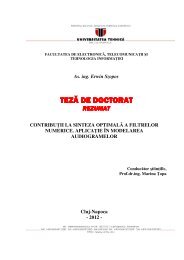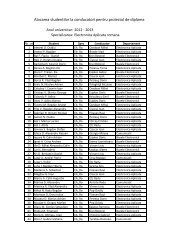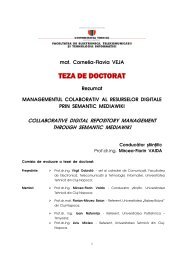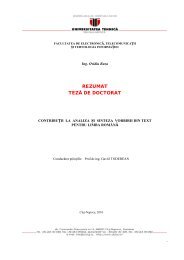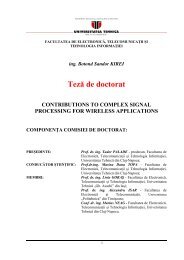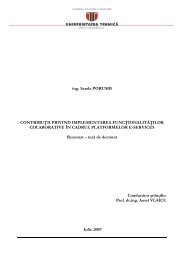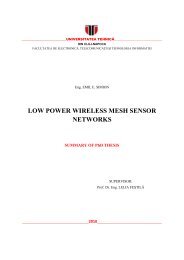SUMMARY PhD. THESIS
SUMMARY PhD. THESIS
SUMMARY PhD. THESIS
You also want an ePaper? Increase the reach of your titles
YUMPU automatically turns print PDFs into web optimized ePapers that Google loves.
. The possibility of acquiring the depth information from the distance by using optical „close-up”<br />
means (lenses); this is a major advantage compared to the methods that use structured light or the<br />
propagation time of some laser beam.<br />
c. The proposed algorithm for „depth from light polarisation” is sufficiently flexible to allow the<br />
implementation on video sequences in real time. This is due to the fact that the implementation is<br />
based on a finite number of simple mathematical operations (multiplications and additions).<br />
d. Both solutions are based on regular 2D photo / video sensors and require minimum<br />
additions/transformations for enabling 3D acquisition.<br />
The research activity, based on the study of different already available technologies, techniques and<br />
algorithms for capturing the depth information for 3D - but also on the actual implementation of an<br />
algorithm for „depth from defocus” and, respectively, on developing a new method that uses<br />
information from light polarisation - proved that the proposed approach could be easily extended and<br />
integrated into future photo/video 3D aware cameras.<br />
Chapter 5 presented an architecture for real-time, pixel-based and frame based processing of high<br />
definition video (1920 x 1080 pixels per frame, 50 frames per second). The implementation, using<br />
FPGA technology and Look Up Tables has the following advantages over the ASIC (”application<br />
specific integrated circuits”) based version:<br />
a. Independence of video processing speed from the complexity of the algorithm that analytically<br />
describes it. So, no matter how complex the expressions used to compute the final pixel value<br />
are, the actual processing is performed in the same amount of time.<br />
b. The possibility of hardware reuse for different processing. The use of the FPGA technology<br />
allows the easy reconfiguration of the processing, including for future 3D video systems.<br />
c. Easy extension and integration of other user defined processing / functions. The proposed<br />
architecture, based on Look Up Tables, enables the addition of further processing functions<br />
according to the user needs.<br />
d. The possibility for integration of third party processing functions that are defined using<br />
proprietary equations and the availability to further ensure copyright protection.<br />
The research effort, resulting in a functional study of a look-up table based video processing<br />
architecture performed using a software simulator, implemented by the author and in a working proofof-concept<br />
hardware model, proved that the approach, as well as the actual integration in a video camera<br />
is feasible.<br />
Chapter 6 closes the thesis with a summary and conclusions of the entire endeavour.<br />
Main Contributions and Conclusions<br />
In the context of the research performed by the author on the existing literature as well as the result of<br />
the implemented simulations and functional models, this thesis brought the following main<br />
contributions to the field of 2D&3D vision systems and state of the art:<br />
a. An overview of the main technological aspects that support the current development of 3D<br />
systems has been realised, namely the advances in CMOS and CCD sensor technology and in<br />
PLASMA, LCD, OLED display technology<br />
5




